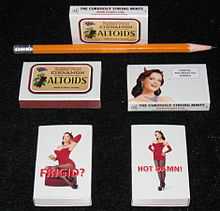Altoids
 | |
| Owner | Wrigley Company |
|---|---|
| Introduced | 1780 |
| Website | www.altoids.com |
Altoids are a brand of breath mints that have existed since the 18th century. Altoids are less widely available in Britain—their country of origin—than in the regions to which they are exported. The mints are stocked in relatively few shops, including Tesco, Morrisons and Waitrose supermarket chains (but not at all locations). Marks And Spencer produces a near identical product called "Curiously Strong Mints". Unlike their marketing in the USA, Altoids have never been heavily marketed in the UK.[citation needed] Callard & Bowser-Suchard formerly manufactured and produced Altoids at a plant in Bridgend, Wales, but Wrigley, the brand's owner, moved Altoids' production to an existing plant in Chattanooga, Tennessee, USA to manufacture the products closer to where they are primarily marketed.[1][2] They were marketed for a brief period in the 1990s under the "Nuttall's" brand when Callard and Bowser was under the ownership of Terry's.
The history of Altoids dates back to the reign of King George III. The brand was created by a London-based Smith & Company in the 1780s but eventually became part of the Callard & Bowser company in the 19th century. Their advertising slogan has been "The Original Celebrated Curiously Strong Mints" for a number of years, referring to the high concentration of peppermint oil used in the original flavour lozenge. The "Story of Altoids" text is printed on the paper liner inside certain tins.[citation needed]
Flavours and varieties


Mints
Altoids mints are currently available in six flavors: peppermint, wintergreen, spearmint, cinnamon, ginger, and liquorice.[3] "Sugar-Free Smalls", tiny square mints sweetened with sorbitol and sucralose, are also available in peppermint, wintergreen, cinnamon, simply mint and Nordic mint. In 2007, dark chocolate-dipped mints were introduced in three flavours: peppermint, cinnamon, and ginger and in 2008, dark chocolate-dipped mints were introduced in crème de menthe. The chocolate dipped varieties were discontinued in 2010. Circa early 2011, Altoids altered the ingredients of their Wintergreen mints, adding blue food coloring. Altoid mints labeled "sugar-free smalls" do not contain gelatin, therefore they are suitable for vegans, vegetarians or those following a halal or kosher diet.
Sours
Sour hard sweets in round tins were introduced in 2002. Flavours include raspberry, lime, apple, tangerine, and mango. They have all been discontinued.
Gum
The sugar-free chewing gum, introduced in 2003, was made in the United States. Flavours include peppermint, cinnamon, spearmint, wintergreen and two sour flavours, cherry and apple. The gum has not been seen in stock in US stores since January 2010 and has been discontinued.[4]
Altoids Strips
In 2003, breath strips in peppermint and cinnamon flavours were introduced. They were discontinued and are no longer available.
Altoids tins
The distinctive tin cases in which Altoids mints are packaged are often reused for other purposes. They have long served as containers for household items like paper clips, coins, sewing materials and other small items.[5][6]
The tins are sometimes used to house electronic projects. BeagleBone, a single-board computer made by Texas Instruments, is deliberately shaped with rounded corners to fit inside the tin.
First aid and survival
Altoids tins have also been popular with outdoor enthusiasts for many years as first-aid or mini survival kit containers. A name for these kits is Bug-Out Altoids Tins, or BOATs.[7]
See also
References
- ↑ Pare, Mike (April 12, 2012). "Life Savers at 100: Wrigley cites Chattanooga plant during celebration". Chattanooga Times Free Press. Retrieved 27 June 2012.
- ↑ "Altoids: Made in America". Prepared Foods Network. September 7, 2005. Retrieved 27 June 2012.
- ↑ "Altoids". Retrieved 2013-08-07.
- ↑ http://www.adafruit.com/blog/2010/04/29/is-wrigleys-mars-inc-killing-off-the-altoids-product-and-brand/
- ↑ "Altoids FAQ: Are Altoids® tins recyclable?". Altoids.com. 2011. Retrieved 2011-08-08. "For over 100 years, Altoids® were packaged in small rectangular cardboard cartons that were approximately the same size as today's recognisable tins. The tins were introduced in the 1920s to help protect the mints and to stay neatly closed in pockets and handbags."
- ↑ "Altoids FAQ: Is there a story behind the Altoids® tin?". Altoids.com. 2011. Retrieved 2011-08-08. "The good news about these tins is that they also come in handy as small storage containers for things like nails, coins, paper clips and buttons to name a few – the possibilities are endless. We've even learned that the tins have been used for more curious purposes – as hand-held works of art, even as an emergency wilderness stove."
- ↑ "sweeper" (January 11, 2008). "Homemade BOAT (Bug Out Altoids Tin)" (PDF). Outdoors-Magazine.com. Retrieved 2011-08-08.
Further reading
- Grant, Jeremy. "New brands take a toll on Wrigley" Financial Times, London Ed. 26-Oct-2005, pg 27.
- Terdiman, Daniel. "Altoids, the curiously strong tin; The container stylishly stores battery chargers, iPods and more." New York Times 2-Feb-2005.
- "Wrigley to buy Altoids and Life Savers from Kraft." Candy Industry ISSN 0745-1032; Volume 169; Issue 11 1-Nov-2004.
- What's News. The Wall Street Journal, Business and Finance, pg A1. 15-Nov-2004.
- Pare, Mike. "Wrigley to invest $14M to make Altoids in its Chattanooga, Tenn., plant." Chattanooga Times/Free Press, Knight Ridder/Tribune Business News. 23-Aug-2005.
External links
- Official Altoids website
- Altoids Chewing Gum Articles
- The Altoids Curiously Strong Awards Video Clip
| |||||||||||||||||||||||||||||||||||||||||||||||||||||